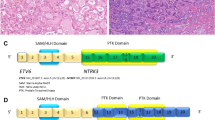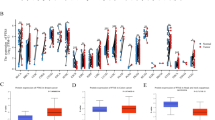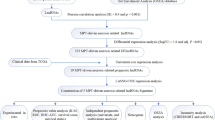Abstract
A large subset of oropharyngeal squamous cell carcinomas (OPSCCs) is associated with HPV infection and has better outcome than non-viral-related tumors. Various malignancies also carry a role for TLRs, key activators of inflammation and innate immunity. We examined the expression of TLRs in OPSCC, and their association with HPV status and treatment outcome. TLR 5, 7, 9, and p16 were studied by immunohistochemistry and HPV status was detected with in situ hybridization in 202 tumors of consecutively treated OPSCC patients using tissue microarray method. The relations between TLR expression and HPV status, p16 expression, clinicopathological factors, and survival were analyzed. TLR 5, 7, and 9 expression patterns differed between HPV-positive and -negative tumors, and they were statistically significantly associated with history of smoking, heavy drinking, tumor site, grade, size (T), metastasis (N), and stage. Moreover, in HPV-positive tumors the expression of TLR 5 and 7 correlated with tumor recurrence. After adjustment, among HPV-positive OPSCC patients, high TLR 5 and low TLR 7 expression were associated with poor disease-specific survival. Our results indicate that TLR 5 and 7 may have a role in the prognostication of HPV-positive OPSCC, however, further studies are needed to clarify the comprehensive role of these TLRs in OPSCC.


Similar content being viewed by others
Abbreviations
- CI:
-
Confidence interval
- CRT:
-
Chemoradiotherapy
- DSS:
-
Disease-specific survival
- HR:
-
Hazard ratio
- ISH:
-
In situ hybridization
- OPSCC:
-
Oropharyngeal squamous cell carcinoma
- RFS:
-
Recurrence-free survival
- RT:
-
Radiotherapy
- SCC:
-
Squamous cell carcinoma
- Sx:
-
Surgery
References
Gillison ML, Koch WM, Capone RB, Spafford M, Westra WH, Wu L, Zahurak ML, Daniel RW, Viglione M, Symer DE, Shah KV, Sidransky D (2000) Evidence for a causal association between human papillomavirus and a subset of head and neck cancers. J Natl Cancer Inst 92(9):709–720
Chaturvedi AK, Engels EA, Pfeiffer RM, Hernandez BY, Xiao W, Kim E, Jiang B, Goodman MT, Sibug-Saber M, Cozen W, Liu L, Lynch CF, Wentzensen N, Jordan RC, Altekruse S, Anderson WF, Rosenberg PS, Gillison ML (2011) Human papillomavirus and rising oropharyngeal cancer incidence in the United States. J Clin Oncol 29(32):4294–4301. doi:10.1200/JCO.2011.36.4596
Nasman A, Attner P, Hammarstedt L, Du J, Eriksson M, Giraud G, Ahrlund-Richter S, Marklund L, Romanitan M, Lindquist D, Ramqvist T, Lindholm J, Sparen P, Ye W, Dahlstrand H, Munck-Wikland E, Dalianis T (2009) Incidence of human papillomavirus (HPV) positive tonsillar carcinoma in Stockholm, Sweden: an epidemic of viral-induced carcinoma? Int J Cancer 125(2):362–366. doi:10.1002/ijc.24339
Rietbergen MM, Leemans CR, Bloemena E, Heideman DA, Braakhuis BJ, Hesselink AT, Witte BI, Baatenburg de Jong RJ, Meijer CJ, Snijders PJ, Brakenhoff RH (2013) Increasing prevalence rates of HPV attributable oropharyngeal squamous cell carcinomas in the Netherlands as assessed by a validated test algorithm. Int J Cancer 132(7):1565–1571. doi:10.1002/ijc.27821
Nichols AC, Palma DA, Dhaliwal SS, Tan S, Theuer J, Chow W, Rajakumar C, Um S, Mundi N, Berk S, Zhou R, Basmaji J, Rizzo G, Franklin JH, Fung K, Kwan K, Wehrli B, Salvadori MI, Winquist E, Ernst S, Kuruvilla S, Read N, Venkatesan V, Todorovic B, Hammond JA, Koropatnick J, Mymryk JS, Yoo J, Barrett JW (2013) The epidemic of human papillomavirus and oropharyngeal cancer in a Canadian population. Curr Oncol 20(4):212–219. doi:10.3747/co.20.1375
Ragin CC, Taioli E (2007) Survival of squamous cell carcinoma of the head and neck in relation to human papillomavirus infection: review and meta-analysis. Int J Cancer 121(8):1813–1820
Ang KK, Harris J, Wheeler R, Weber R, Rosenthal DI, Nguyen-Tan PF, Westra WH, Chung CH, Jordan RC, Lu C, Kim H, Axelrod R, Silverman CC, Redmond KP, Gillison ML (2010) Human papillomavirus and survival of patients with oropharyngeal cancer. N Engl J Med 363(1):24–35
Mroz EA, Forastiere AA, Rocco JW (2011) Implications of the oropharyngeal cancer epidemic. J Clin Oncol 29(32):4222–4223. doi:10.1200/JCO.2011.37.8893
Mirghani H, Amen F, Blanchard P, Moreau F, Guigay J, Hartl DM, Lacau St Guily J (2015) Treatment de-escalation in HPV-positive oropharyngeal carcinoma: ongoing trials, critical issues and perspectives. Int J Cancer 136(7):1494–1503. doi:10.1002/ijc.28847
Janeway CA Jr (1989) Approaching the asymptote? Evolution and revolution in immunology. Cold Spring Harb Symp Quant Biol 54(Pt 1):1–13
Kawai T, Akira S (2005) Pathogen recognition with Toll-like receptors. Curr Opin Immunol 17(4):338–344
Matzinger P (2002) The danger model: a renewed sense of self. Science 296(5566):301–305
Matzinger P (1994) Tolerance, danger, and the extended family. Annu Rev Immunol 12:991–1045
Basith S, Manavalan B, Yoo TH, Kim SG, Choi S (2012) Roles of toll-like receptors in cancer: a double-edged sword for defense and offense. Arch Pharm Res 35(8):1297–1316. doi:10.1007/s12272-012-0802-7
Ioannou S, Voulgarelis M (2010) Toll-like receptors, tissue injury, and tumourigenesis. Mediat Inflamm. doi:10.1155/2010/581837
Jouhi L, Datta N, Renkonen S, Atula T, Makitie A, Haglund C, Ahmed A, Syrjanen S, Grenman R, Auvinen E, Lehtonen S, Hagstrom J (2015) Expression of toll-like receptors in HPV-positive and HPV-negative oropharyngeal squamous cell carcinoma-an in vivo and in vitro study. Tumour Biol 36(10):7755–7764. doi:10.1007/s13277-015-3494-z
Kauppila JH, Mattila AE, Karttunen TJ, Salo T (2013) Toll-like receptor 5 (TLR5) expression is a novel predictive marker for recurrence and survival in squamous cell carcinoma of the tongue. Br J Cancer 108(3):638–643. doi:10.1038/bjc.2012.589
Zhou H, Chen JH, Hu J, Luo YZ, Li F, Xiao L, Zhong MZ (2014) High expression of Toll-like receptor 5 correlates with better prognosis in non-small-cell lung cancer: an anti-tumor effect of TLR5 signaling in non-small cell lung cancer. J Cancer Res Clin Oncol 140(4):633–643. doi:10.1007/s00432-014-1616-4
Klimosch SN, Forsti A, Eckert J, Knezevic J, Bevier M, von Schonfels W, Heits N, Walter J, Hinz S, Lascorz J, Hampe J, Hartl D, Frick JS, Hemminki K, Schafmayer C, Weber AN (2013) Functional TLR5 genetic variants affect human colorectal cancer survival. Cancer Res 73(24):7232–7242. doi:10.1158/0008-5472.CAN-13-1746
Grimm M, Kim M, Rosenwald A, Heemann U, Germer CT, Waaga-Gasser AM, Gasser M (2010) Toll-like receptor (TLR) 7 and TLR8 expression on CD133 + cells in colorectal cancer points to a specific role for inflammation-induced TLRs in tumourigenesis and tumour progression. Eur J Cancer 46(15):2849–2857. doi:10.1016/j.ejca.2010.07.017
Ni YH, Ding L, Zhang DY, Hou YY, Huang X, Hu Q (2015) Distinct expression patterns of Toll-like receptor 7 in tumour cells and fibroblast-like cells in oral squamous cell carcinoma. Histopathology 67(5):730–739. doi:10.1111/his.12703
Kauppila JH, Takala H, Selander KS, Lehenkari PP, Saarnio J, Karttunen TJ (2011) Increased Toll-like receptor 9 expression indicates adverse prognosis in oesophageal adenocarcinoma. Histopathology 59(4):643–649. doi:10.1111/j.1365-2559.2011.03991.x
Korvala J, Harjula T, Siirila K, Almangush A, Aro K, Makitie AA, Grenman R, Karttunen TJ, Leivo I, Kauppila JH, Salo T (2014) Toll-like receptor 9 expression in mucoepidermoid salivary gland carcinoma may associate with good prognosis. J Oral Pathol Med 43(7):530–537. doi:10.1111/jop.12160
Ronkainen H, Hirvikoski P, Kauppila S, Vuopala KS, Paavonen TK, Selander KS, Vaarala MH (2011) Absent Toll-like receptor-9 expression predicts poor prognosis in renal cell carcinoma. J Exp Clin Cancer Res CR 30(1):84. doi:10.1186/1756-9966-30-84
Vaisanen MR, Jukkola-Vuorinen A, Vuopala KS, Selander KS, Vaarala MH (2013) Expression of Toll-like receptor-9 is associated with poor progression-free survival in prostate cancer. Oncol Lett 5(5):1659–1663. doi:10.3892/ol.2013.1204
Leppanen J, Helminen O, Huhta H, Kauppila JH, Isohookana J, Haapasaari KM, Lehenkari P, Saarnio J, Karttunen TJ (2017) High toll-like receptor (TLR) 9 expression is associated with better prognosis in surgically treated pancreatic cancer patients. Virchows Arch 470(4):401–410. doi:10.1007/s00428-017-2087-1
Makinen LK, Atula T, Hayry V, Jouhi L, Datta N, Lehtonen S, Ahmed A, Makitie AA, Haglund C, Hagstrom J (2015) Predictive role of Toll-like receptors 2, 4, and 9 in oral tongue squamous cell carcinoma. Oral Oncol 51(1):96–102. doi:10.1016/j.oraloncology.2014.08.017
Makinen LK, Hayry V, Atula T, Haglund C, Keski-Santti H, Leivo I, Makitie A, Passador-Santos F, Bockelman C, Salo T, Sorsa T, Hagstrom J (2012) Prognostic significance of matrix metalloproteinase-2, -8, -9, and -13 in oral tongue cancer. J Oral Pathol Med 41(5):394–399. doi:10.1111/j.1600-0714.2011.01110.x
Nichols AC, Finkelstein DM, Faquin WC, Westra WH, Mroz EA, Kneuertz P, Begum S, Michaud WA, Busse PM, Clark JR, Rocco JW (2010) Bcl2 and human papilloma virus 16 as predictors of outcome following concurrent chemoradiation for advanced oropharyngeal cancer. Clin Cancer Res 16(7):2138–2146. doi:10.1158/1078-0432.CCR-09-3185
El-Naggar AK, Chan JKC, Grandis JR, Takata T, Slootweg PJ (eds) (2017) WHO classification of head and neck tumours, vol 9, 4th edn. IARC, Lyon
Park JH, Yoon HE, Kim DJ, Kim SA, Ahn SG, Yoon JH (2011) Toll-like receptor 5 activation promotes migration and invasion of salivary gland adenocarcinoma. J Oral Pathol Med 40(2):187–193. doi:10.1111/j.1600-0714.2010.00929.x
Song EJ, Kang MJ, Kim YS, Kim SM, Lee SE, Kim CH, Kim DJ, Park JH (2011) Flagellin promotes the proliferation of gastric cancer cells via the Toll-like receptor 5. Int J Mol Med 28(1):115–119. doi:10.3892/ijmm.2011.656
Cherfils-Vicini J, Platonova S, Gillard M, Laurans L, Validire P, Caliandro R, Magdeleinat P, Mami-Chouaib F, Dieu-Nosjean MC, Fridman WH, Damotte D, Sautes-Fridman C, Cremer I (2010) Triggering of TLR7 and TLR8 expressed by human lung cancer cells induces cell survival and chemoresistance. J Clin Invest 120(4):1285–1297. doi:10.1172/JCI36551
Cherfils-Vicini J, Damotte D, Fridman WH, Sautes-Fridman C, Cremer I (2010) Human lung cancer: role of TLR7 and TLR8 in cell survival and chemoresistance. MS 26(4):435–437. doi:10.1051/medsci/2010264435
Ahn MY, Kwon SM, Cheong HH, Park JH, Lee J, Min SK, Ahn SG, Yoon JH (2012) Toll-like receptor 7 agonist, imiquimod, inhibits oral squamous carcinoma cells through apoptosis and necrosis. J Oral Pathol Med 41(7):540–546. doi:10.1111/j.1600-0714.2012.01158.x
Dewan MZ, Vanpouille-Box C, Kawashima N, DiNapoli S, Babb JS, Formenti SC, Adams S, Demaria S (2012) Synergy of topical toll-like receptor 7 agonist with radiation and low-dose cyclophosphamide in a mouse model of cutaneous breast cancer. Clin Cancer Res 18(24):6668–6678. doi:10.1158/1078-0432.CCR-12-0984
Gotz C, Drecoll E, Straub M, Bissinger O, Wolff KD, Kolk A (2016) Impact of HPV infection on oral squamous cell carcinoma. Oncotarget 7(47):76704–76712. doi:10.18632/oncotarget.12501
Park JH, Yoon HE, Jeon DI, Ahn SG, Yoon JH (2010) Activation of TLR2 and TLR5 did not affect tumor progression of an oral squamous cell carcinoma, YD-10B cells. J Oral Pathol Med 39(10):781–785. doi:10.1111/j.1600-0714.2010.00900.x
Burdelya LG, Krivokrysenko VI, Tallant TC, Strom E, Gleiberman AS, Gupta D, Kurnasov OV, Fort FL, Osterman AL, Didonato JA, Feinstein E, Gudkov AV (2008) An agonist of toll-like receptor 5 has radioprotective activity in mouse and primate models. Science 320(5873):226–230. doi:10.1126/science.1154986
Hasan UA, Bates E, Takeshita F, Biliato A, Accardi R, Bouvard V, Mansour M, Vincent I, Gissmann L, Iftner T, Sideri M, Stubenrauch F, Tommasino M (2007) TLR9 expression and function is abolished by the cervical cancer-associated human papillomavirus type 16. J Immunol 178(5):3186–3197
Fathallah I, Parroche P, Gruffat H, Zannetti C, Johansson H, Yue J, Manet E, Tommasino M, Sylla BS, Hasan UA (2010) EBV latent membrane protein 1 is a negative regulator of TLR9. J Immunol 185(11):6439–6447. doi:10.4049/jimmunol.0903459
van Gent M, Griffin BD, Berkhoff EG, van Leeuwen D, Boer IG, Buisson M, Hartgers FC, Burmeister WP, Wiertz EJ, Ressing ME (2011) EBV lytic-phase protein BGLF5 contributes to TLR9 downregulation during productive infection. J Immunol 186(3):1694–1702. doi:10.4049/jimmunol.0903120
Vincent IE, Zannetti C, Lucifora J, Norder H, Protzer U, Hainaut P, Zoulim F, Tommasino M, Trepo C, Hasan U, Chemin I (2011) Hepatitis B virus impairs TLR9 expression and function in plasmacytoid dendritic cells. PLoS One 6(10):e26315. doi:10.1371/journal.pone.0026315
Shahzad N, Shuda M, Gheit T, Kwun HJ, Cornet I, Saidj D, Zannetti C, Hasan U, Chang Y, Moore PS, Accardi R, Tommasino M (2013) The T antigen locus of Merkel cell polyomavirus downregulates human Toll-like receptor 9 expression. J Virol 87(23):13009–13019. doi:10.1128/jvi.01786-13
Acknowledgements
We thank Mrs. Elina Aspiala and Mrs. Päivi Peltokangas for technical assistance and Mr. Tero Vahlberg for statistical advice. This work was supported by the Orion Farmos Foundation, the Research Foundation of Finnish Otolaryngological Association, the Sigrid Jusélius Foundation, and the Finnish Dentist Association Apollonia.
Author information
Authors and Affiliations
Corresponding author
Ethics declarations
Conflict of interest
The authors declare no conflict of interest.
Electronic supplementary material
Below is the link to the electronic supplementary material.
Rights and permissions
About this article
Cite this article
Jouhi, L., Mohamed, H., Mäkitie, A. et al. Toll-like receptor 5 and 7 expression may impact prognosis of HPV-positive oropharyngeal squamous cell carcinoma patients. Cancer Immunol Immunother 66, 1619–1629 (2017). https://doi.org/10.1007/s00262-017-2054-3
Received:
Accepted:
Published:
Issue Date:
DOI: https://doi.org/10.1007/s00262-017-2054-3




